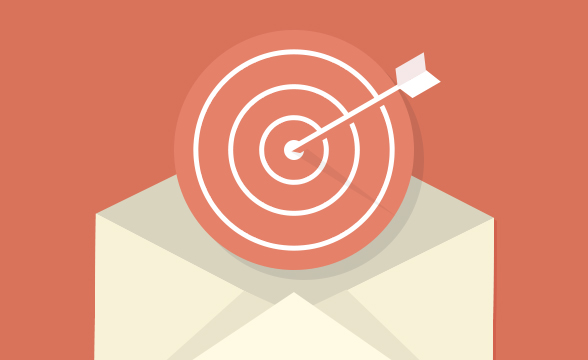Email marketing still accounts for over 15% of all ecommerce sales, but how are you using the other 85% of channel sales opportunities to help new customers? This is how you can adopt a comprehensive strategy to help serve New Customers across HubSpot Email, Chatbost, Service, Site, Ads, and Sales.
I’ve personally analyzed sales data for over 150+ of our customers over the last 7 years and - with the exception of probably 3 businesses - I never see a repeat conversion rate that's above 50%. (Incidentally I’ve seen that the repeat conversion rate in the Fashion & Apparel and Consumables sector is consistently lower, around 25-40%)
This means that no matter the work done to close that first sale, the larger battle is closing the second order. For many of our merchants, even a slight change from a 48% repeat purchase rate to a 48.5% repeat purchase rate can add a huge spike to their monthly order revenue.
You can create raving fans just from your entire end-to-end new customer onboarding process that will move the needle on your repeat purchase rate. Welcoming New Customers is one of the many critical areas of focus in an overall Ecommerce Customer Segmentation strategy.
This article is about using the channels at your disposal in HubSpot to create meaningful and helpful interactions that delight your new customers:
- New Customer Email Series
- New Customer Chatbots
- New Customer Live Chat/Priority Support
- Post-Sale Dynamic Site Content
- New Customer Retargeting Ads
A customer’s first order with your business is an extension of their trust, and fortunately you have a huge opportunity to fulfill that trust during this first 30-60 days of their purchase to help them feel welcomed and at home with your brand.
From their standpoint after first ordering, they still have to wait for your product to show up at your door, have positive interactions with every touch point from your brand, have a great experience with your product along with how it helps them accomplish their intended goals.
Remember that NOT communicating with your new customer isn’t a neutral experience. It’s subconsciously a negative one, even if your competitors are also similarly doing nothing in terms of new customer followup.
Let’s go for that “wow” factor through hyper-personalized automation and followup with new customers.
Channel #1: New Customer Email Series
We provide a $250 Ecommerce Marketing System with email and workflow templates that include New Customer Welcoming but I'm going to give a short version of the strategy principles and setup of this campaign series.
Regardless of email platform, there are two major campaign phases to a New Customer Welcome email strategy:
- New Customers | 1. Welcome & Educate - Send helpful content over two emails to your brand new customers that will meet the needs of 80% of your buyers and make them feel welcomed and engaged
- New Customers | 2. Nurture 2nd Order - Once enough time has passed where a customer SHOULD have made a 2nd purchase by now but hasn't, you'll use 2 emails to send them some incentive ($ or % off coupon) to close that 2nd sale (since at least 50% of 1st time buyers never buy again, any reminder nudge towards that 2nd sale is critical)
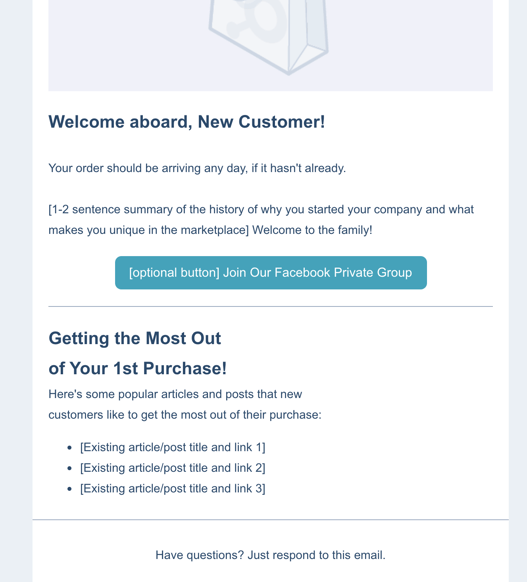
Above is a templated example of a first email. Remember that they're still waiting for their order to arrive in the mail at this point, and you may wan to send the 2nd email around day 7 after their order would have arrived at their door.
Here's some example items you might want to share through the 2-email content to build trust, education, and create an emotional connection with your brand:
- Put Images of People in the Email: Your first email might share an image (or animated GIF) of your smiling staff, and your 2nd email might share an image of people enjoying your products
- Share Top-Viewed Content That's Relevant to New Buyers: You will undoubtably have some blogs or social posts that customers have found helpful to get the most out of the product. Even if they'd seen them before, they weren't a customer before, so that change makes them worth re-sharing. For Fashion & Apparel, style guides and outfit matching are a great fit here.
- Share a How-To Video: If you've got a video of how to use your products that will cover 80% of use cases, share it! Again, they're a customer now so that context change makes seeing it again perfectly helpful!
- Share Common Post-Sale FAQs: Definitely list the most commonly asked questions about your product use or ordering, with links to your knowledge base articles
- Share Links to Private Facebook/Social Groups: Not every business type warrants this, but if a "private club" concept is meaningful or relevant to your buyers this is the best possible time to connect them with a community other like-minded customers they can engage
- Invite Them to Activate Their Rewards/Referrals Program: If you use Smile.io or another similar tool, this is a good time to remind them they can start building points off the purchase they just made
Covering 2nd sale incentive offers isn't the point of this article, I'm more concerned with using these channels to make sure the customer is wowed with their first purchase.
But simply put I'd send email 3-4 after the time they should have organically made a 2nd purchase (but didn't) and put a fixed coupon in place with a product grid of top-selling products they could look at and consider. I'd also highly recommend sending a product/purchase review email to get feedback on their experience before sending those next purchase emails, so 5 emails in total. (I'll cover this topic further in another article)
HubSpot How-To
A reminder, don't forget to associate each email with a "New Customer" HubSpot Campaign for performance and revenue tracking.
You'll want to trigger the HubSpot Workflow off a Smart List, which I'd recommend calling "New Customers | 1. Welcome & Educate - #ADD to Emails/Audiences/Site Promos", or something like that.
Using Unific's default Contact Properties, here's some example criteria of how I'd set up the Smart List criteria:
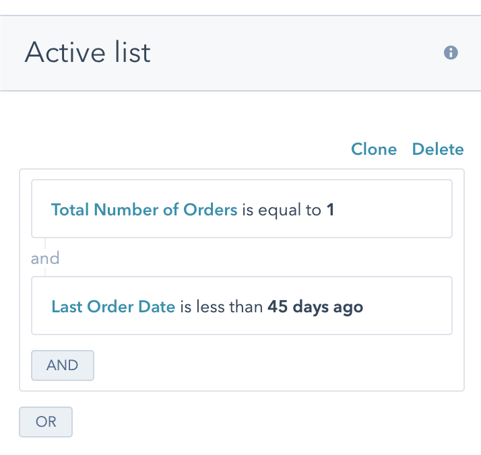
Why use a Smart List vs just raw criteria in the Workflow Trigger?
It can make it easier to monitor who currently qualifies in that "New Customer" range, and more importantly it allows this list to serve as triggers for the other 4 channel types below.
Channel #2: New Customer Chatbots
When implemented right, a Chat Bot functions like a personal search function that can pop up on any page of your website. It’s no substitute escalating an issue to a customer service person, but research from Drift has shown that 37% of people will use a customer service bot to get quick answers in an emergency.
You want to set up a Chat Bot that’s specifically set up to answer a brand new customer’s most relevant questions. A brand new customer likely won’t be asking about your latest deals because they just bought, so don’t prioritize pre-sales questions in your bot logic and make sure it’s launched with common post-sale questions, first.
The new customer may be concerned about everything from order arrival to product education to discussing the need for returns.
Even if they can’t get the problem fully solved through the bot, being able to end the chat with them knowing a customer service rep will have all of the needed context when they arrive is a huge trust-builder.
Here’s an article of the top 6 questions customers are asking Ecommerce chat bots and some of the highlights I saw that would pertain to the first 30-60 days after a new customer buys:
- “Where’s my order?”
- “I need to make a return. What’s your refund policy?”
- “When are you guys open today?”
That article is from 2019 and I’m sure these responses will evolve over time. Talk to your support team who are aware of your new customer’s trust-extending world to see what questions get commonly asked. You might find common product-specific concerns like:
- “How do I protect my new shoes against wear and tear?”
- “How long does it take to see results?”
- “It doesn’t fit right. What’s your exchange policy?”
- “How long should my supplements last?”
- “Do you have a guide or video on how to use it?”
- “Do you have examples from other customers?”
You may notice that a lot of these common topics can (and should) also be covered in the New Customer Email series. It may seem like you’re repeating yourself, but you’re really not. You want to offer a consistent set of messaging and help no matter where the customer prefers to interact.
In a chatbot tool like HubSpot, you can have questions like these pull up related series of Knowledge Base articles for a customer to click on, and you can offer the links to these exact same FAQ’s in your email onboarding.
Customers are busy, they might not look at one channel like email. Or they might look at it but then forget because they have a lot going on and the question becomes relevant again once the product is actually in their hand.
As a word of caution: Do NOT try to pretend that your chatbot is a real person, but rather call it your “Support Bot”, or something like that.
Consumers are familiar enough with Siri and Alexa to know that there are certain ways they have to phrase things with computers to get results, and this will also create a grace for them in the interaction.
You don’t want customers feeling they’ve got the rug pulled from under them when they thought they were talking to a person, or have the chat devolve into all-caps complaints like, “DO YOU SPEAK ENGLISH?!”.
That does not add plus-points to the new customer’s experience, so call it a “Support Bot” from the onset.
And I wouldn’t worry about these for your Version 1 (or even version 3), but here’s a fun bonus article of small talk questions you can program into your bot logic that will help to give your chatbot an on-brand personality for your company.
HubSpot How-To
Here’s a knowledge base article on how to set up a HubSpot chat bot in detail, as well as a great video tutorial of how to built a HubSpot chatbot. (FYI, they now call them "chatflows")
The important part though is the New Customer targeting part of the bot, which is what’s most important to this article.
After setting up your Chatflow logic, go into the "Target" section of the menu
- After deciding on what website Pages or Query parameters you DO or do NOT want the chatbot showing up at, go into the "Visitor information and behavior (Optional)" section
- Select "When" and select "Segmented lists"
- Add the Smart List you created above, "New Customers | 1. Welcome & Educate - #ADD to Emails/Audiences/Site Promos"
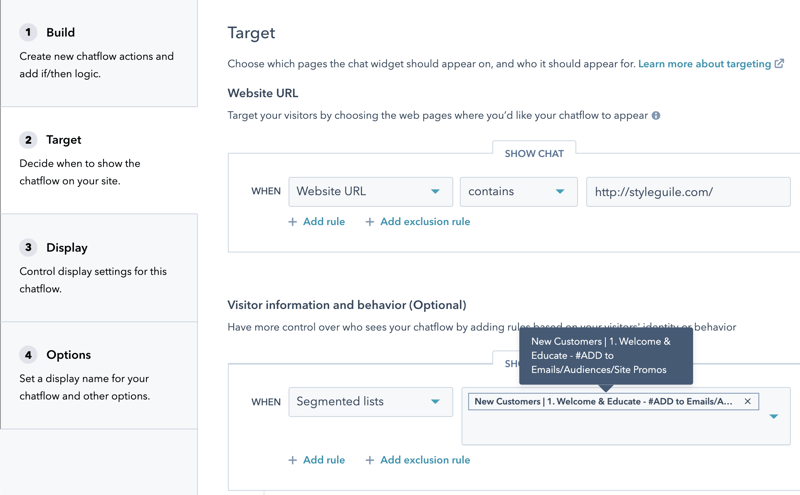
Obviously, this depends on the site visitor being properly cookied so that HubSpot knows it's that particular customer, so if they're returning to the site from another computer or phone where they haven't interacted with the HubSpot UTK, this won't work. But for a large portion of customers who do have the tracking enabled, this is how they will get that specific chat help!
Also, in the main Chatflows menu make sure to put this "New Customer Welcome" chatbot as the top priority item in the list!
Channel #3: New Customer Live Chat/Support Priority
Here’s where we get into the real-people component of chat and support so that your team can prioritize these brand new customers!
A note about prioritized support: The complaint among many is that this creates a “tiered class” of customers that cares about new business and just kind of leaves all existing customers to fend for themselves as though they’re not important.
At most, if your team aims for a 2-day resolution time with new customers then existing customers should max out at 3-4 days. Having a back log of tickets because someone isn’t “new” and you "already have their business” is not a customer-first mindset and I’m completely NOT saying that.
What I am saying though is that new customers are in this delicate phase where you still actually haven’t earned their trust, yet. They’ve trusted you enough to make that first purchase, but because of the great things that Amazon has done for the ecommerce industry they're relying on an amazing experience or convenient return if everything doesn't go according to plan.
For a brand new customer, their tolerance for issues is still very fragile if there are other similar options in your market space and you need to be sensitive of that.
HubSpot How-To
If you're on HubSpot's Service Hub for managing your support, it's easy to prioritize Tickets generated from New Customers.
- Create a Ticket checkbox property called, "Ticket Made During New Customer Welcome?" or something similar
- Set up filters in your support team's Ticket views that can prioritize if that checkbox is "Yes" if needed
- Create and activate a Ticket Workflow per the screenshot below (unfortunately you can't look for a Smart List in a Ticket workflow so you need to re-build the raw criteria from the "New Customers | 1. Welcome & Educate - #ADD to Emails/Audiences/Site Promos" list; keep this in mind if you need to change that list criteria down the road)
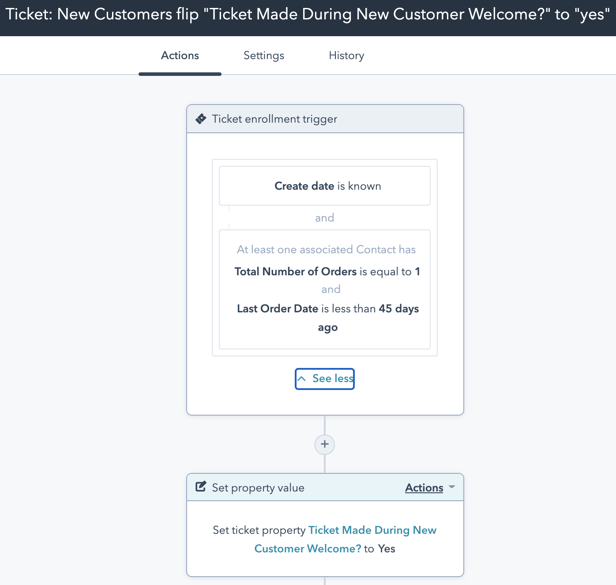
Here's some other advice to implement for helping your Support team prioritize new customers:
- Build "New Customer" Specific Snippets: Keep building a running Snippet list of common new customer issues (The only disadvantage of using Snippets is that HubSpot has no reporting tools available for snippet use, showing the amount of times a snippet was loaded into an email and sent, nor the open and click rates for those. If you do want to get a sense of “issue” specific reporting, I’d use Templates for all New Customer type interactions.)
- Implement Customer Feedback Surveys for Tickets: HubSpot has a great article on NPS and other feedback survey types, and you want to make sure a survey goes out after every ticket close to make sure your customer satisfaction stays high.
Channel #4: Post-Sale Dynamic Site Content
Creating dynamic content on your site that changes based on where they came from, purchases they've made, or past form submissions and pages visits is one of the most powerful strategies available to digital marketers
HubSpot doesn't enable you to change your product and category pages, but there are some key ways you can implement dynamic site content using HubSpot tools, especially if you've implemented an Inbound methodology for attracting leads.
HubSpot How-To
- Contextual Landing Page Forms: If you've got your traffic driving landing pages built in HubSpot, you can offer completely different webforms if you know the customer has already bought from you or some other activity. A PDF offer of product comparisons could be replaced with a PDF offer for getting the most out of their purchase with a checklist
- Progressive Fields in Webforms: Even if it's displayed on your Ecommerce site, you can dynamically swap out form fields you're asking for if you've already collected that information from past purchases or form submissions. A popular place do do this is on blog pages where you're asking about topic interest, which could be swapped to product-specific use case fields if they've already bought from you. Here's a good writeup on use cases for progressive fields.
- Smart Call to Action (CTA): Placable anywhere on your website (and in emails), you can change the text/image and link of a button to offer the visitor somewhere else to go based on their past behavior.
- Dynamic Popups/Banners: If you're using HubSpot's Popup tool, you can swap a general 15% off discount to an offer for a more specific second purchase recommendation. This article also discusses the popup/banner use case.
Channel #5: New Customer Retargeting Ads
“Spending ad money on my existing customers? That’s insane. They already bought from me, why would I spend more ad money on them?”
Remember that at least 50% of your customers will only purchase once. They are not loyal or bonded to your business, yet.
If sent at the right time and to the right group of customers, retargeting your existing New Customer list can be a great way to keep your brand top of mind.
This is where some napkin math will have to come into play. Need to do some analysis of what your typical customer lifetime is worth, and how much of your best customers are shouldering the burden of your not so great customers.
I can cover the targeting of higher-potential customers in another post, but some basic ideas of retargeting content include:
- Advertising Community-Building or How-To Content About Your Products: This is where promoting articles your customers have liked that help them get the most out of your product could be valuable. If you have a private community Facebook group, you could run ads to these customers about the benefits of engaging in that community
- Sending 2nd Purchase Ideas Around When They Should Buy Again: This requires an understanding of your typical repeat purchase times, but maybe at the 45-60 day mark after their purchase you could start sending ads that offer a carousel of popular next purchase products
- Customer Starts to Become Unresponsive to Marketing Emails: If a customer is no longer engaging in your marketing emails, there's a good chance that some "We miss you" messaging would still be effective on social
HubSpot How-To
HubSpot allows you to create Ad Audience lists inside of HubSpot using Smart Lists, so you'd use that "New Customers | 1. Welcome & Educate - #ADD to Emails/Audiences/Site Promos" list we established earlier to send to Google or Facebook.
Note that a list needs at least 20 contacts in order to create an audience list, but to get the most out of your ad spending (since the match rate won't be a perfect 100%) it's recommended that you use a list with at least 1,000 members.
If you don't have 1000 members in your new customer list though, just use what you've got and see how it goes.
I will also note that you'll want to use a separate, new list for 2nd purchase retargeting that lines up more with the times where customers SHOULD have made a 2nd purchase but aren't. You don't want to be spending ad money on people who are still focused on using their 1st purchase, nor do you want to spend on people who might have bought again, anyway, because of your followup from other low-cost channels.
I'd recommend setting up a Smart List with a title like "New Customers | 2. Nurture 2nd Order - #ADD to Emails/Audiences/Site Promos" and using some criteria such as these (the exact days depends on an analysis of your customers' typical repurchase timelines):
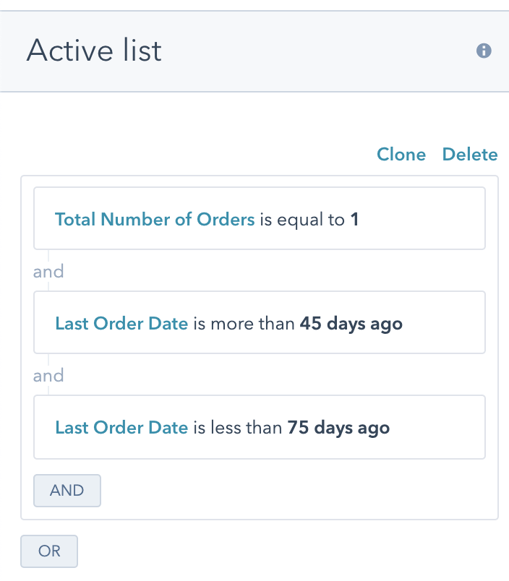
Prepping for the Holidays
We're coming on the time of year that creates the biggest revenue and new customer gains for retailers. Implementing this work across all of these channels so that it can be part of your holiday strategy is a great way to make sure you can be helpful to the influx of new customers you'll get.
An important note about applying this to holidays: Be careful, specifically about your Ad Retargeting strategy for New Customers during the holiday shopping season, and possibly delay that component until the end of the year. Increasingly customers are having holiday surprises ruined by seeing evidence of their purchases and browsing follow them around Google, Facebook, and elsewhere. Take that at your own risk, since the average consumer may not be aware of how retargeting works and may not take the necessary steps to preserve the surprise.
Some Guide Rails for Success
Consumers are bombarded with contact from all forms of various companies across all channels they interact with. Your goal with using multiple channels is not necessarily the volume of content but rather the consistency of message and experience across mediums, along with knowing how your customers PREFER to be contacted.
Different channels have different strengths. Though I'm not covering it here, this is a great writeup of the advantages of SMS marketing as a channel.
Some customer bases are really responsive to SMS or Facebook Ads or Messenger. Some customers don’t use Facebook and hate getting bothered in a text instant message fashion.
As the basis of a Persona analysis, look at your list of top 1-5% of customers, talk with some of them. Ask how they prefer communication. Figure out the 20% of communication channels that will lead to 80% of your results and prioritize those channels first.
If you want to do a cool Facebook retargeting campaign but your ideal, best customers don’t use Facebook and prefer they come to you on support chat/emails, then deprioritize the Facebook component and focus your chat/support system around helping new customers.
I've commonly seen that email marketing also be overdone, with 9+ long email series that aren't tied to any specific product purchase where the content could be consolidated to much fewer emails. (I've also commonly seen these brands simultaneously sending out weekly sales promotion emails to new customers who just bought from them: my strong suggestion is to filter all new customers out of regular Newsletter lists for their first 30-45 days of onboarding so that all content is focused around them getting the most out of their first purchase.)
For a first purchase, 4-5 follow up emails should be more than enough to be helpful, friendly, available, and top-of-mind during that customer's onboarding. Any other outbound mediums you choose (ad retargeting, phone calls, direct mail, SMS, etc) should not try to copy-paste the same content across every medium but figure out a seamless way for them to work together.
Create a cohesive brand message that still works if a customer sees all, none, or some of your communication by putting yourself in their shoes:
- What if they saw EVERY piece of content I'm sending across all channels? Would that be annoying?
- What if they only seeing ONE channel of content I'm sending? Would it still make sense?
- What if they only see ONE PIECE of the content I'm sending? Would that still be enough for them to take an intended action and build a more positive relationship with our company?
This is hard work to do well, and part of the reason that multi-channel campaigns are rarely tackled.
But because repeat purchase rates are less than 50%, welcoming new customers is the best possible lifecycle stage to utilize multiple channels to be helpful to your new buyers.
More Advanced Strategies (For Later)
The goal of this article was to help implement a New Customer welcoming strategy that will apply perfectly to the majority of your customer base, regardless of what they purchase.
Obviously though there will likely be key-indicators within your customer data of new customer types you need to pay special attention to, and using Unific's Contact Properties you can create other segments for more targeted welcoming.
Whenever you explore this though, make sure to apply the 80/20 principle. What are the 20% of new customer types that lead to 80% of long term revenues or create the most issues that require special attention?
This will take some analysis and understanding of your data but here's the two most common segment types I've seen over the years:
- Segmentation Based on 1st Order Value: When doing a historical analysis of all customers I commonly find that the top 1-5% of customers (those that provide 5-10x the spending of your average customers) typically spend a larger amount from even their very first order. If you've identified this order value break point it can be a strong indicator that these 1st time buyers show potential to become your best customers, so you'd want to follow up with them with a specific proactive phone call
- Content Based on Product/Category Type: Commonly there's product categories or even specific products that require special customer attention. Maybe you sell a modular product so you want to follow up with those that buy the base unit in their 1st purchase. Or maybe there's simply a particular high-value product that's responsible for a large portion of your revenue and it's worth following up with that smaller base of customers to make sure they're happy with their purchase
Additional Channels NOT Covered Here
Frankly, these are harder to implement but I’d be amiss to not talk about them:
- New Customer Proactive Phone Calls (Sales Hub!): I briefly cover the common segments in the last section, but customers who spend a large amount in their 1st order or buy from specific product/categories may be an opportunity for your Sales Team (or your Service Team using the Sales Hub tool for email Sequences and call logging) to track a list of customers they need to follow up on, which get removed from their list after HubSpot detects that Sales Hub contact was made
- SMS Messaging: Frankly, this is harder to implement in HubSpot, period, because it's not designed as a B2C tool like Klaviyo and doesn't have SMS built in, but I've worked with clients who've connected Twilio and Zapier to trigger SMS messages out of HubSpot workflows. The sending part isn't complicated, but because many states require explicit consent for phone marketing, managing two-way subscribe and unsubscribe syncing between Twilio and HubSpot via Zapier is what makes this hard.
- Direct Mail: There are two popular direct mail services for HubSpot - Enthusem and Postalytics - that make direct mail campaigns in HubSpot relatively easy to pull off, but like your Ad strategy Direct Mail comes with hard costs that need to be monitored along with implementing all of the creative and content. If you sell products that are conducive to repeat sales (Consumables or Fashion & Apparel come to mind) then a Direct Mail campaign can be a strong way to help you stand out from the crowd!
Building that Attract->Convert->Delight Flywheel
Taking a wholistic, multi-channel approach to New Customer Welcoming gives your business the best possible chance of growing repeat orders. Doing so will also create good word of mouth for future new buyers to build that flywheel of happy customers that creates momentum for your overall growth.
If you prioritize the channels that are most important to your customers as you tackle this critical lifecycle stage, you can make a measurable impact on your company's growth for the future.
Get a Free Customer Journey Analysis!
Identify actionable differences in your ecommerce customer behavior to focus your marketing efforts. Our subscription eliminates many workflow and report building steps from this article.
